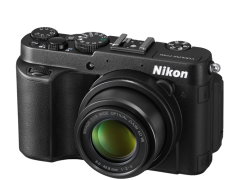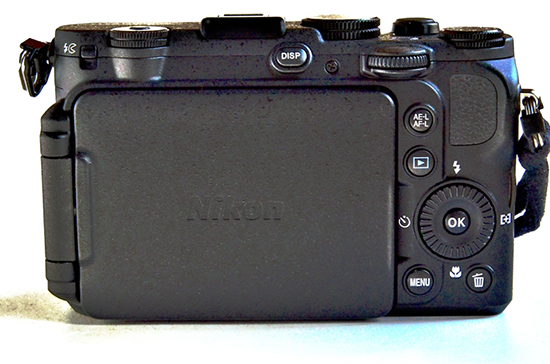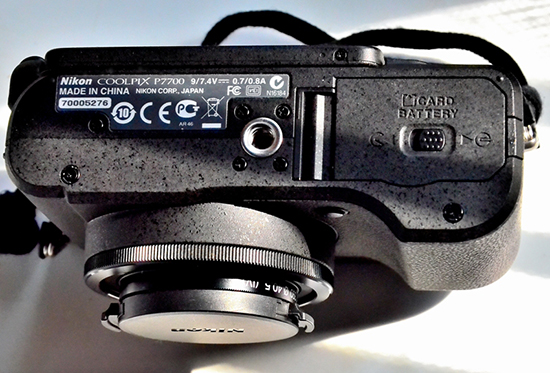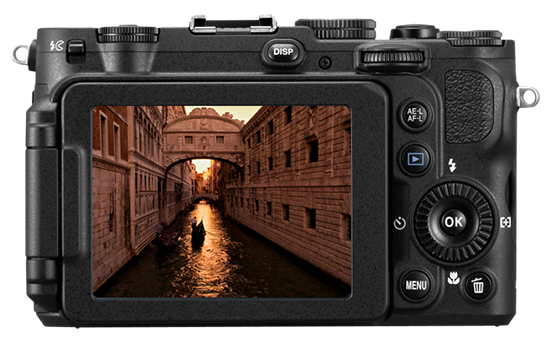 This is part II of Nikon Coolpix P7700’s hands-on-review. Refer part I of the review here.
This is part II of Nikon Coolpix P7700’s hands-on-review. Refer part I of the review here.
The Back Plate Of The Camera
A glance at the well-populated back plate will show that the P7700 means business.
We‘ve discussed the vertically sliding control that activates the pop-up flash. We’ve also covered the well-knurled dials on the top deck, so we can now turn our attention to the Disp button. Pressing this changes the amount of exposure-related data on the LCD monitor during replay. Each successive press of this button nudges the amount of data available on-screen, going from no data to minimal to comprehensive (which includes a tone-map with a movable cursor to highlight various areas with the same tone, for accurately exposing a particularly perplexing scene in terms of giving priority to the most important tonal areas). This is not something casual shooters may need or appreciate, but for the experienced shooter, it is manna from heaven.
Beyond lies the heavily knurled main command dial that enables changes to the flexible program when shooting, controls shutter speed in S and M modes, and helps scroll through images in replay.
The comfortable, well ramped rubberised thumb rest offers good purchase to the shooting hand, while the AE/AF lock button does just that, being also configurable through the menu for either of the two actions. Below that is the image replay button, denoted by a right arrow, in blue. Then there is the multi-selector dial-cum-ring.

The Back Plate Of The Camera
The multi-selector control has, at the cardinal points of the compass (moving clockwise) options for the self timer, flash, AF Area and focus mode. The knurled rotary multi-selector ring responds smoothly to thumb rotation, to let you access sub-menus or scroll through images, which the main command dial also does. The OK button is, as always, used to lock in a selection.
In manual focus mode, pressing up or down at north or south points moves the focus point back and forth, while turning the knurled ring helps to fine tune it.
Lastly, we have the menu button and the familiar delete button (configurable through the menu for one of two ways of effecting deletes), with its easily recognizable trashcan motif.
The vari-angle TFT LCD screen is a bright, fully articulated, 3″ affair, folding out 90◦ and rotating 180◦ to even face the subject (great for self portraits or group shots with the help of the ML-L3 remote).
There is not the slightest wobble or jerkiness in its deliciously smooth and positive action. 921K dots is more than enough to give a very high resolution: it’s moot whether a higher-res screen (of this size) can actually be appreciated by the unaided human eye. When the screen is folded flat against the body with its back facing outwards, the camera can’t be switched on, thus preventing accidental activation in a bag or pocket. This position also protects the screen from damage.
The plethora of information available on-screen can be judged by looking at the picture above. If you count carefully, you will see about 20 bits of vital information including WB, ISO, virtual horizon, histogram, VR on, movement warning, picture control, macro, P mode, exposure information, battery condition, shots remaining, flash off, matrix metering set, Active D-lighting, NR (noise reduction on), left dial on top plate set to Picture Quality, RAW, full resolution set and exposure compensation on -1. A nightmare for the unskilled snap-shooter, this camera is the enthusiast / professional’s dream come true.
The Bottom Plate
There is little here for the tourist. Firstly, there’s the camera manufacturer’s label mentioning source, model number and other sundry information.
Near the centre is the standard ¼” tripod socket, while on the extreme left is a cavity, covered by a spring-loaded cover, that accommodates the proprietary EN-EL 14 Nikon battery and memory card. This battery / memory card compartment, in turn, is sited within the hand grip.
And with that, we come to the end of our survey of the camera’s beautiful, marbled black, mottled-finish exterior and its external features. It’s now time to peer under the bonnet.

The Bottom Plate
Menu, Options & Settings
Depending on the shooting mode, pressing the menu button throws up a list of options. For instance, in P shooting mode, it offers the following items in the shooting menu:
• Custom picture control.
• Metering.
• Continuous … i.e., drive mode.
• AF Area mode … Subject Tracking and Target Area Mode are unavailable.
• Autofocus mode.
• Flash exp. Compensation.
• Noise reduction filter … i.e., 3 levels of NR as well as off.
• Built-in ND filter.
• Distortion control.
• Active D-Lighting … i.e., Nikon’s proprietary tone management system. Note that when it is enabled, the metering options are greyed out.
• Zoom memory.
• Startup zoom positions… these are configurable in seven focal lengths – 28, 35, 50, 85, 105, 135 and 200 mm, mimicking real-life focal lengths.
• M exposure preview… i.e., the effects of shooting settings are visible on-screen, a very helpful feature indeed.
• Focus coupled metering… not recommended.
• Commander mode… i.e., set it when the pop-up flash is configured to control an off-camera flash such as the Nikon SB-700.
The only other menu option is the setup menu, which displays the following sub-menu options:
• Auto off … i.e., the time the LCD monitor stays on.
• Format card.
• Language.
• TV settings.
o Video mode.
o HDMI.
o HDMI device control.
o HDMI 3D output.
• External mike (level of) sensitivity.
• Customize command dials.
• Command dial rotation.
• Multi selector right press (off or on).
• Delete button options (two options).
• AE/AF lock button (AE lock, AF lock, AE (hold) both AE and AF).
• Fn1 + shutter button (configure).
• Fn1 + command dial (configure).
• Fn1 + selector dial (configure).
• Fn1 guide display.
• Fn2 button.
• Customize My Menu.
• Reset file numbering.
• GPS options.
• Eye-Fi upload.
• MF distance indicator units.
• Reverse indicators -0+… i.e., select which way to turn the dials.
• Flash control.
• Reset all.
• Firmware version.
The Final Verdict
Designing a camera involves a whole set of compromises. A larger sensor means higher quality images and superior low light capability. But it also means that the lens becomes much bulkier and can be slow at the long end. If the lens is shrunk, the zoom range also shrinks. Weight, IQ, size, zoom range, low light capability, operating speed are all parts of this fluid equation.
The P7700 impressed me with its lens based VR, its superb optical quality and its vast array of controls that gives the users maximum control over the shooting experience, enriching it beyond almost every digital camera I have yet owned.
If shot-to-shot times weren’t all that hot, if a buffer full of RAW images took several seconds to clear, if tracking focus at higher speeds meant that the LCD blacked out, if there was a one-second lag between pressing the shutter button (there is no dedicated movie button) and start of recording, all I have to say is that I don’t normally shoot sports, anticipate the action when I do and press the button accordingly, and though life is short, it isn’t that short that I can’t spare a few seconds for this noble instrument to recover from a long burst. I’m not that hard a taskmaster.
A major consideration that weighed with me while selecting the P7700 was that it uses the same EN-EL 14 battery as my D5100 and D3100 DSLRs. Other common accessories are the Nikon speedlights, the GP-1 GPS unit, the ML-L3 and MC-DC2 remote control units. Coupled with the sterling qualities of the P7700 on paper (and confirmed in the field – it is a superb picture taking device, one that puts the F back in Fun), I am very glad I opted for it.

In time, as technology advances (and as Nikon parsimoniously adds features from higher models, e.g., the faster Expeed C3 processor and, perhaps, an EVF ?), the P7700 will evolve further. Indeed, after seeing the reaction of buyers to the trailblazing Sony RX100 and its superior image / low light capability, not only Nikon but other manufacturers must already be planning their next move. I won’t be surprised if there is soon a glut of compact cameras with 2/3” or even 1” type sensors. But till then, I intend making the most of the wonderful P7700.
There is no denying the fact that given its size, it ought to have had at least a 2/3” sensor and a faster, more sophisticated processor. Even if the lens had then shrunk to a 28-140 mm zoom, why, that’s what the Canon PowerShot G15 has right now! Backed by more efficient software, a 2X digital zoom would still give 280 mm at the long end, which is quite enough for most users.
But within the compromises that Nikon had to deal with, I feel the P7700 is an excellent outcome and I have no hesitation in recommending it strongly, especially because of the value it offers at a very modest price.

